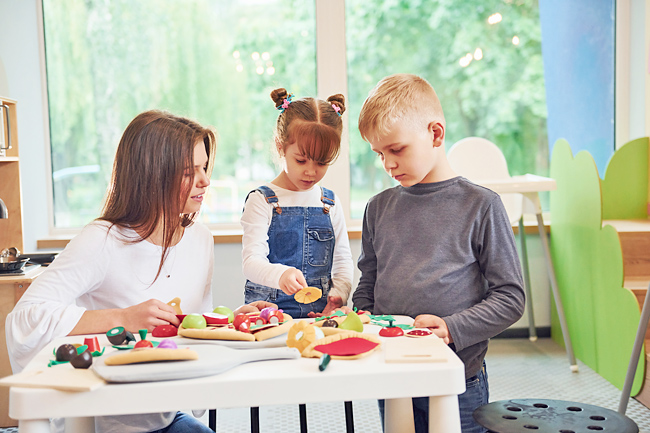Alexandra Moe
THE WASHINGTON POST – It’s after school, and the tweens are rowdy with angst. Then two of them, Charlotte Williams, 13, and Tally Vogel, 11, face each other. Williams raises an arm, and Vogel raises her arm to follow. They’re practising “the mirror”, an improv exercise in a theatre classroom, and the room suddenly hushes. It’s indistinguishable which girl is leading, and which is following. When the exercise stops, and the teacher asks how they were able to sync up so completely without speaking, Vogel said, “I used my eyes.”
In other words, she used “active listening”, a type of verbal and non-verbal communication skill that promotes mutual understanding.
Several studies show communication skills are the most essential skills for navigating American adult life – better communicators are hired more often, enjoy happier relationships and marriages, ascend to leadership positions, and possess higher self-esteem. The ability to manage personal emotions and to recognise them in others – also known as emotional intelligence – is a predictor of academic and professional success.
These skills are often taught through Social Emotional Learning programmes, offered in K-12 schools in 27 states.
But they are also a by-product of theatre class, according to a recent study from George Mason University and the Commonwealth Theatre Centre. The study follows children aged five to 18 over six years – the longest look at theatre’s impact in kids to date – and finds increases in communication skills across age, gender and race. “The longer the kids spent in the theatre classes, the more they gained in 21st Century skills, like communication, creativity, imagination, problem solving, and collaboration,” said the study’s co-author and an associate professor of applied developmental psychology at George Mason University Thalia Goldstein.


Theatre involves “active learning” – getting up on your feet to take in information, rather than merely sitting at a desk. “When you put something in your body, it’s more durable, it lasts longer, and you remember it longer,” said Associate Professor of theatre at the University of Texas at Austin Kathryn Dawson. And theatre involves more than one “mode”: verbalising, while making a gesture or expression, which research shows boosts brain activity.
It’s something parents, whether they realise it or not, are surrounded by. Parents of young children are familiar with pretend play – the couch is suddenly a frog castle, the floor a lake, and unbeknown to you, sharks are circling your ankles.
It may seem like pure fantasy, but in fact, pretend play is the foundation for developing empathy, Goldstein said. It helps young children build emotional understanding, regulation and executive function, the foundational skills that later predict empathy levels.
Parents can help foster empathy in children by introducing fiction books throughout childhood, with varied characters, settings and authors, which correlates directly to empathy scores in adulthood. They can let them be the drivers of pretend play, authors of their own stories. And theatre class is yet another way.
It’s the social dynamic of theatre, the give and take, the volley of listening and responding, that expands kids’ capacity to read cues, think quickly and creatively, work as an ensemble and see things from another perspective.
Theatre provides an awareness of space, pausing, waiting for somebody else to talk.
For children with autism, improv techniques increase eye attention and reciprocity of conversation, said co-founder of Act As If Lisa Sherman, a communications programme that specialises working with autistic youth. And this is where the arts level the playing field for children of different abilities; they can participate in meaningful ways where language is not a requisite skill.
A study among K-2 children in San Diego showed that participating in activities in drama and creative movement significantly improved English-speaking skills among children from primarily Spanish-speaking homes. Children with the most limited English benefitted the most, said the study’s co-author Christa Greenfader, an assistant professor of child and adolescent studies at California State University at Fullerton.
During the 2021-2022 school year, more than 4,000 immigrant youth enrolled in public schools in Montgomery County in Maryland, the majority from Central and South America. On a recent Tuesday, teaching artist Hilda Tijerina held a map before a class of 18 teenagers. This was Sharon Faber’s ‘Theatre Class for Emergent English Learners’ at Watkins Mill High School, one of 27 classrooms in nine schools where Imagination Stage, a theatre arts organisation, hosts workshops called Oyeme! (Hear Me!). Most of the teenagers had arrived to the United States (US) within the year. They spoke little English and were there to express themselves. They sat stoically.
“Where are we?” Faber asked the class. “Dónde?” Tijerina translated, pointing at the map. “In Maryland!” a smattering of students answered.
Then Tijerina asked the teenagers to rise from their desks and form a circle. Those who liked what she said were to walk to the centre, while saying a sentence in English. “Who likes sports?” she asked. “I like sports!” most of the class called back, gathering in the middle.
“Who likes high school?” she called out again. Half called back, “I like high school!” as she corrected their pronunciations.
Elvis, 17, arrived from El Salvador six month ago and said theatre exercises helped him remember English words for days of the week, months and numbers. For Brissya, 14, improv allowed her to practice English with classmates.
She moved to the next activity, illustrating on a white page what she would do with USD1 million. Beside a drawing of a shirt and pants, she wrote “buy some clothes” in English.
Connecting is ultimately the goal of communication, and it is the reason the actor Alan Alda began using improv exercises with scientists. Scientists are trained to speak methodically, defend their arguments and use niche jargon, a communication style that doesn’t always land with a general audience, said Executive Director of the Alda Center for Communicating Science Laura Lindenfeld. Through improv, they are taught to make mistakes and laugh about it, to “give ourselves permission to fail and move on”.
“When scientists come into a room, they’re like, ‘Oh man, you’re going to put me through improv?’ ” she said. But after exercises like “the mirror”, looking intently into other people’s eyes, they realise they can’t succeed unless they’re in touch with the other person.
Speaking becomes about making a human connection rather than pushing information – and that’s the point. You may have the most wonderful scientific finding, but if no one understands it, what’s the use?
Sara Williams, mother to Charlotte, cites theatre as the foundation for her daughter’s self-awareness. Charlotte began drama classes at age five. At 13, she is not afraid to speak publicly or join the student council; she listens and has confidence. “They go to these classes and come home feeling energised, like they accomplished something,” Williams said. And not just the outgoing kids – for the shy, theatre opens them up. For children with anxiety, like so many children coming out of the pandemic, “the least judgemental place you can be is in a theatre class”. You can keep your personality, and unlike in sports, you’re not competing with anyone.
In the end, theatre is about telling stories. It is one of the best ways to help young people get to know themselves, Dawson said. Stories help us make sense of the world and understand another’s experience.





